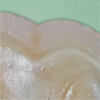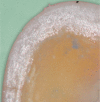Effect of Immediate Dentin Sealing on Polymerization of Elastomeric Materials: An Ex Vivo Randomized Controlled Trial
- PMID: 31866712
- PMCID: PMC6898876
- DOI: 10.5005/jp-journals-10005-1657
Effect of Immediate Dentin Sealing on Polymerization of Elastomeric Materials: An Ex Vivo Randomized Controlled Trial
Abstract
Statement of problem: Interactions are suspected between resin coating and elastomeric impression material.
Purpose: The purpose of this study was to identify possible interactions between two impression materials and resin-coated tooth surfaces.
Materials and methods: Extracted molars (n = 10) underwent 1 of the 4 procedures: control group (unsealed tooth surface/impression); IDS group (immediate dentin sealing/impression); IDS/AB group (immediate dentin sealing/air blocking/impression); IDS/AB-P group (immediate dentin sealing/air blocking/pumicing/impression). Dentin bonding agents used were Adper single bond 2 and Clearfil SE bond. Impression materials used were Impregum Soft (polyether) and Aquasil (A silicone). A stereomicroscope was used to detect any residual impression material on the bonded tooth surface.
Results: The IDS group showed 100% faulty impressions. Air blocking the resin coating did not completely eliminate the oxygen-inhibited layer of Adper single bond 2. Clearfil SE Bond along with Aquasil generated ideal impressions in group IDS/AB, while all other combinations resulted in faulty impressions. The IDS/AB-P group yielded ideal impressions with Aquasil but generated faulty impressions with Impregum soft in most specimens.
Conclusion: Immediate dentin sealing should be followed by air blocking and pumicing to generate ideal impressions with Aquasil (A silicone). Impregum Soft (polyether) is not recommended in combination with immediate dentin sealing.
How to cite this article: Khakiani MI, Kumar V, et al. Effect of Immediate Dentin Sealing on Polymerization of Elastomeric Materials: An Ex Vivo Randomized Controlled Trial. Int J Clin Pediatr Dent 2019;12(4):288-292.
Keywords: Dentin bonding agent; Elastomers; Immediate dentin sealing; Oxygen inhibition layer.
Copyright © 2019; Jaypee Brothers Medical Publishers (P) Ltd.
Conflict of interest statement
Source of support: Nil Conflict of interest: None
Figures










Similar articles
-
Substantial in-vitro and emerging clinical evidence supporting immediate dentin sealing.Jpn Dent Sci Rev. 2021 Nov;57:101-110. doi: 10.1016/j.jdsr.2021.05.004. Epub 2021 Jul 21. Jpn Dent Sci Rev. 2021. PMID: 34354787 Free PMC article. Review.
-
Interactions between impression materials and immediate dentin sealing.J Prosthet Dent. 2009 Nov;102(5):298-305. doi: 10.1016/S0022-3913(09)60178-5. J Prosthet Dent. 2009. PMID: 19853171
-
Significance of immediate dentin sealing and flowable resin coating reinforcement for unfilled/lightly filled adhesive systems.J Esthet Restor Dent. 2021 Jan;33(1):88-98. doi: 10.1111/jerd.12700. Epub 2021 Jan 6. J Esthet Restor Dent. 2021. PMID: 33404184
-
Does immediate dentin sealing influence the polymerization of impression materials?Eur J Dent. 2014 Jul;8(3):366-372. doi: 10.4103/1305-7456.137650. Eur J Dent. 2014. PMID: 25202218 Free PMC article.
-
Immediate dentin sealing for indirect bonded restorations.J Prosthodont Res. 2016 Oct;60(4):240-249. doi: 10.1016/j.jpor.2016.04.001. Epub 2016 Apr 27. J Prosthodont Res. 2016. PMID: 27131858 Review.
Cited by
-
Bond Strength Evaluation of Ceramic Restorations with Immediate Dentin Sealing: A Systematic Review and Meta-Analysis.J Dent (Shiraz). 2024 Sep 1;25(3):192-202. doi: 10.30476/dentjods.2023.97057.1986. eCollection 2024 Sep. J Dent (Shiraz). 2024. PMID: 39371953 Free PMC article. Review.
-
Substantial in-vitro and emerging clinical evidence supporting immediate dentin sealing.Jpn Dent Sci Rev. 2021 Nov;57:101-110. doi: 10.1016/j.jdsr.2021.05.004. Epub 2021 Jul 21. Jpn Dent Sci Rev. 2021. PMID: 34354787 Free PMC article. Review.
-
Immediate Dentin Sealing: A Literature Review.Clin Cosmet Investig Dent. 2021 Jun 21;13:233-256. doi: 10.2147/CCIDE.S307939. eCollection 2021. Clin Cosmet Investig Dent. 2021. PMID: 34188553 Free PMC article. Review.
-
Effect of Immediate Dentin Sealing on the Bonding Performance of Indirect Restorations: A Systematic Review.Biomimetics (Basel). 2024 Mar 17;9(3):182. doi: 10.3390/biomimetics9030182. Biomimetics (Basel). 2024. PMID: 38534867 Free PMC article. Review.
References
-
- Pashley EL, Comer RW, et al. Dentin permeability: sealing the dentin in crown preparations. Oper Dent. 1992;17:13–20. - PubMed
-
- Bertschinger C, Paul SJ, et al. Dual application of dentin bonding agents: effect on bond strength. Am J Dent. 1996;9:115–119. - PubMed
-
- Paul SJ, Schärer P. The dual bonding technique: a modified method to improve adhesive luting procedures. Int J Periodontics Restorative Dent. 1997;17:536–545. - PubMed
-
- Magne P, Douglas WH. Porcelain veneers: dentin bonding optimization and biomimetic recovery of the crown. Int J Prosthodont. 1999;12:111–121. - PubMed
LinkOut - more resources
Full Text Sources
Research Materials
